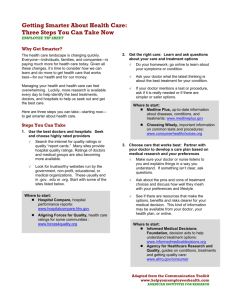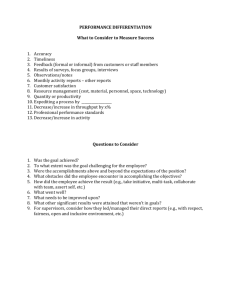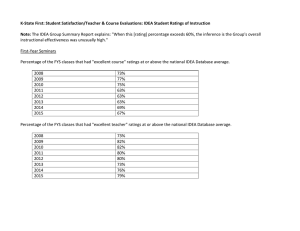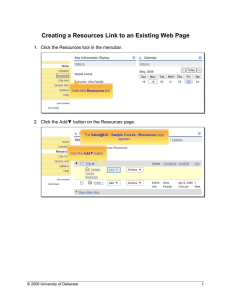The Quality of Health Care in Delaware: What Delawareans Say About Their
advertisement
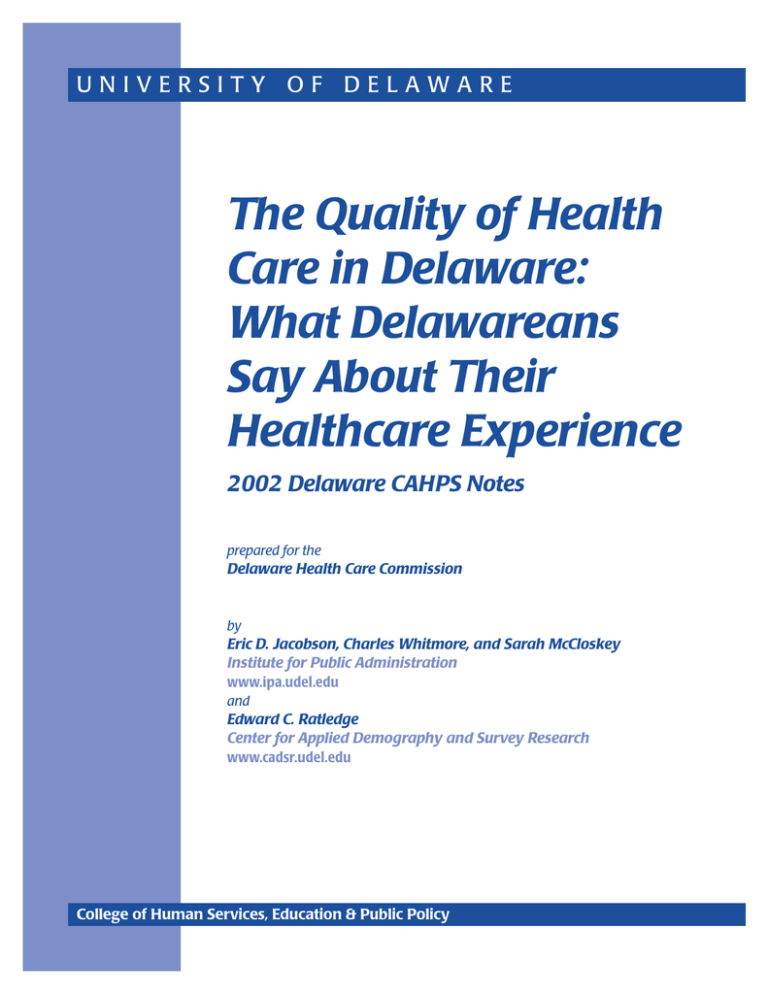
UNIVERSITY OF DELAWARE The Quality of Health Care in Delaware: What Delawareans Say About Their Healthcare Experience 2002 Delaware CAHPS Notes prepared for the Delaware Health Care Commission by Eric D. Jacobson, Charles Whitmore, and Sarah McCloskey Institute for Public Administration www.ipa.udel.edu and Edward C. Ratledge Center for Applied Demography and Survey Research www.cadsr.udel.edu June 2003 College of Human Services, Education & Public Policy The University of Delaware is committed to assuring equal opportunity to all persons and does not discriminate on the basis of race, color, gender, religion, ancestry, national origin, sexual preference, veteran status, age, or disability in its educational programs, activities, admissions, or employment practices as required by Title IX of the Educational Amendments of 1972, Title VI of the Civil Rights Act of 1964, the Rehabilitation Act of 1973, the Americans with Disabilities Act, other applicable statutes, and University policy. Inquiries concerning these statutes and information regarding campus accessibility and Title VI should be referred to the Affirmative Action Officer, 305 Hullihen Hall, 302-831-2835 (voice), 302-831-4563 (TDD). ii TABLE OF CONTENTS Page List of Figures and Tables…………………………………………………………………. iv Executive Summary ............................................................................................................... 1 The Importance of Measuring Quality...........................................................................………2 Comparison of Delaware to NCBD ...............................................................................………3 Summary of Delaware Findings ....................................................................................………6 Health Plan Enrollment..............................................................................................................9 Differences Across Health Plan Types ......................................................................................9 Differences Across Regions.....................................................................................................12 About the Delaware Survey .....................................................................................................15 About CAHPS and the National CAHPS Benchmarking Database ........................................15 Explanation of Consumers’ Reports on Their Experiences with Care ....................................16 Explanation of Consumers’ Ratings of Their Health Care ......................................................16 Conclusion ...............................................................................................................................17 iii LIST OF FIGURES AND TABLES Figure Page 1A Comparison of Consumer Ratings: Delaware vs. NCBD .............................................................. 4 1B Comparison of Consumer Ratings: Delaware vs. NCBD .............................................................. 5 2 Summary of Delaware Ratings, 2000 – 2002 ................................................................................ 6 3A Summary of Consumer Reports on Experiences-Part I, 2000 – 2002 ........................................... 8 3B Summary of Consumer Reports on Experiences-Part II, 2000 – 2002 .......................................... 8 4 Summary of Health Plan Enrollment by Region ............................................................................ 9 5 Summary of Health Plan Ratings by Plan Type, 2000 – 2002 .................................................... 10 6 Summary of Experiences with Getting Care Quickly by Plan Type, 2000 – 2002 ..................... 11 7 Summary of Health Care Ratings by Region, 2000 – 2002 ......................................................... 12 8 Summary of Health Plan Ratings by Region, 2000 – 2002 ......................................................... 13 9 Summary of Experiences with Health Plan Customer Service by Region, 2000 – 2002 ............ 14 Table 1 Delaware CAHPS Summary of Global Ratings ............................................................................. 7 iv What Consumers Say About the Quality of Their Health Plans and Medical Care 2002 Delaware CAHPS Notes Prepared for the Delaware Health Care Commission by Eric Jacobson and Charles Whitmore, Institute for Public Administration, and Edward C. Ratledge, Center for Applied Demography and Survey Research, College of Human Resources, Education & Public Policy, April 2003. Executive Summary With exponential increases in health care costs on the horizon for the foreseeable future, providing higher quality health care is seen as one way to stem these increases. Efforts to measure and track quality have assumed increasing significance of late. In the world of health policy, the pendulum is swinging toward issues of quality. As if to punctuate the emergence of quality measurement in health care, a prodigious compilation of data was assembled and synthesized to produce a report on the current state of health care quality in the United States. The National Healthcare Quality Report, developed by the Agency for Healthcare Research and Quality (ARHQ), uses 147 measures—several derived from the National CAHPS Benchmarking Database (NCBD)—to gauge quality in everything from the screening for cervical cancer to the immunization of respiratory diseases to the chronic care provided in nursing homes. Finding high quality health care to be anything but universal, the report notes that 37 of 57 areas with trend data have either shown no improvement or have worsened. The report card is the first comprehensive, national effort to measure the quality of health care for the entire country. The 2002 Delaware CAHPS Notes represents one such effort at the state level. The purpose of this report is to illustrate how Delawareans rate various health care providers and report on their specific experiences with the health care system—presenting summary results from the 2002 Delaware CAHPS study. The CAHPS survey instrument is a useful guide to policymakers seeking to improve both Delaware’s health plans and the health care providers deliver to patients. It is the intent of this report to supply the relevant stakeholders and policymakers with objective, experience-based information regarding the quality of health care provided in Delaware. Equipped with three years of survey data, we generate comparisons of Delaware to national data benchmarks. We also discuss overall ratings and experiences with care within Delaware, as well as health plan enrollment characteristics, and differences across plan types and regions. Overall, both Delawareans and CAHPS respondents nationwide rate their doctors, specialists, health plans, and health care experiences highly. On a ten-point rating scale, with “10” the best possible rating and “0” the worst, the vast majority of respondents give ratings of at least a “7.” With just one exception, a clear majority of Delawareans and CAHPS respondents nationwide report the most positive responses for questions that target specific experiences. In Delaware, for example, 86.4% of respondents give the most positive response to questions about getting needed care. Subtle shifts in specific trends mark this year’s report. With respect to health plan enrollment, the number of enrollees in managed care has continued its gradual growth, while numbers of fee-for-service enrollees have dropped correspondingly. Sussex County residents reported higher ratings and more positive experiences with personal doctors and health plans last year as compared to participants from other regions. This year, however, those differences have been muted as the percentage of Sussex respondents giving the most positive ratings has decreased while Kent and New Castle have increased. Within managed care plan ratings, the differences in ratings between loosely managed plans and stricter plan types have decreased. This is a continuation of what we saw in the 2001 CAHPS report. 1 The Importance of Measuring Quality Quality measurement is fast becoming the critical issue in health policy. Why? First, quality measurement improves patient outcomes and decreases morbidity. As a recent study in The New England Journal of Medicine highlights, Americans typically receive only half of the care recommended by the current medical best practices.1 The quality “gap” between care that is proven to work and the care that is actually delivered is an astonishingly wide, gaping chasm. Quality measurement will be an indispensable tool in exposing, and narrowing, this gap. Second, quality measurement saves money. George Halvorson and George Isham, in their new book Epidemic of Care, hit this theme often. After all, the authors note, “It costs a lot more to do [health] care wrong. It saves a lot of money to do it right.”2 Measuring quality identifies wrong care and right care. Consider these two themes—improved patient outcomes and cost savings—then consider the devastating toll of “quality gaps” in the health care system. According to a recent National Committee for Quality Assurance (NCQA) report, this is the annual tally for failure to deliver appropriate, quality health care: 57,000 avoidable deaths, 41 million sick days, over $11 billion in lost productivity, and billions in hospital costs. These massive costs could be avoided, NCQA writes, “if well known ‘best practices’ were more widely adopted.” The “quality gap” between what we know and what we do is expensive, and it is crippling. In its seminal report, To Err Is Human: Building a Safer Health System, the Institute of Medicine (IOM) exposes the appallingly high number of medical errors that cripple the nation’s health care system. IOM finds that “At least 44,000 people, and perhaps as many as 98,000 people, die in hospitals each year as a result of medical errors that could have been prevented.” All to often, doctors operate on the wrong side of the brain, remove the wrong kidney, and fail to prescribe beta blockers to heart attack victims. And while many thousands of people die from medical errors, many thousands more die because known health conditions are not adequately monitored and controlled. Put another way, more than one thousand Americans die each week because the care they get is not consistent with the care that medical science says they should get. The health care infrastructure to drastically curtail these incidences of medical neglect, to prevent life-threatening mistakes from recurring, is not yet in place. Quality measurement is the first step in building such an infrastructure. The IOM’s Crossing the Quality Chasm report, released in March 2001, is in many ways the prism through which quality measurement is viewed. Taking a macro view of health care system, the purpose of the report is to “improve the health and functioning of the people of the United States.” IOM articulates six principles to guide quality improvement: safety, effectiveness, patient-centeredness, timeliness, efficiency, and equity. IOM’s influence in quality circles is unmistakable. A recent Medicare Payment Advisory Commission (MedPAC) report to Congress, emphasized that the overall goals for quality of care in the Medicare program shall be consistent with those recommended by the IOM, namely, “that care be safe, effective, patientcentered, and timely.” Indeed, IOM helped to shape the framework for the National Healthcare Quality Report. And Donald M. Berwick, the Harvard professor and CEO and President of the Institute for Healthcare Improvement, in a recent Health Affairs article, calls for “more sophisticated, extensive, and informative measurement of performance and outcomes, especially with respect to the six [IOM] aims for improvement.” Berwick’s contribution expands on IOM aims (and confers legitimacy to CAHPS-based measures), particularly with respect to patient-centeredness, concluding that “patient’s experiences should be the fundamental source of the definition of ‘quality’.” 1 Elizabeth A. McGlynn, et al. “The Quality of Health Care Delivered to Adults in the United States.” The New England Journal of Medicine. 2003. Vol. 348, No. 26. 2 George C. Halvorson and George J. Isham, M.D. Epidemic of Care. Jossey-Bass. 2003. p.18. 2 Reporting quality information is a critical second step. The reason, pointed out in Epidemic, is that “care improves when quality is reported publicly.” 3 As a private, non-profit organization that assesses and reports on the quality of the nation’s managed care plans, NCQA collects information regarding quality of care, access to care, and satisfaction with health plans and doctors, then generates report cards, making them publicly-available so that consumers can compare provider performance before they purchase a plan. Taking quality information public improves quality of care because consumers—armed with quality data—will demand the best, while providers become incentivized to meet that demand. Doctors, for example, have a strong incentive to improve their management of diabetic patients when they know that their performance will be monitored publicly. If consumers receive better care when quality is measured and reported, they also receive less expensive care. Poor quality, inappropriate care is expensive care. The Kaiser Family Foundation (KFF), like NCQA, estimates that “Not providing the best treatments costs the United States more than $1 billion per year in avoidable health care bills.” (KFF Daily Report, 9/22/03) Some estimates are even higher. Unnecessary and avoidable episodes of congestive heart failure and preterm births create many billions of dollars in unnecessary and avoidable expenditures. Some analyses estimate that closing the “quality gap” could generate cost-savings ranging from 15% to 30% of the country’s $1.4 trillion annual health care tab (Wall Street Journal, 12/23/03). But closing this gap begins with quality measurement. Measuring quality further enables payers and providers to level the tremendous quality variations that exist nationwide. “There are ‘enormous variations’ in health plans’ rates of delivering the most-effective treatments or services” (KFF Daily Report 9/22/03)—and this variation in quality is quite expensive. Dr. John Wennberg, known for his research in health care variation, predicts that, “Medicare could trim 30% of its $285 billion budget by bringing the highest-spending regions of the U.S. in line with the rest.” (WSJ, 12/23/03) Recent initiatives, like ones taken by CMS, Leapfrog Group, and NCQA, aim to narrow the “quality gap,” improving health care and saving money for all Americans. In Delaware, rigorous quality measurement and quality-improvement efforts are essential if Delawareans are to receive a better value for the more than $3 billion spent annually on health care. Based on national trends, more Delawareans are more concerned with the quality of their health care than ever before, but they have precious little information at their disposal. This report aims to address that concern. Comparison of Delaware to National CAHPS Benchmarking Database (NCBD) Presented below are two sets of comparisons: 1) consumer ratings (e.g., on a scale of 1 to 10, how would you rate your health plan?) and 2) consumer reports of specific experiences with care (e.g. how often did you get care as soon as you wanted?). Consumer Ratings • 3 Overall, both Delawareans and CAHPS respondents nationwide rate their health plan and health care experiences highly. For example, on a ten-point rating scale, with “10” the best possible rating and “0” the worst, the vast majority of Delaware’s respondents give ratings of at least a “7” on questions asking about their overall health care and health plan (91.8% and 79.8%, respectively). Similarly, the NCBD reports that 87% and 79% of respondents rate their health care and their health plans “7” or higher. Ibid. p. 29. 3 • Higher ratings are also the rule for personal doctors and specialists. Most Delaware respondents give ratings of at least a “7” to their doctors and specialists (89.1% and 87.7%, respectively), while the NCBD reports that 88% and 87% of respondents rate their doctors and specialists “7” or higher. • Figure 1A examines the percentage of respondents who gave only the highest ratings (“9-10”) for their health plans, health care, doctors, and specialists, comparing the percentage differences between Delaware and NCBD data. The figure presents two years of data and highlights the similarities between Delaware’s findings and the NCBD data. Figure 1A: Comparison of Consumer Ratings: Delaware vs. NCBD • For any one consumer ratings comparison, Delaware and the NCBD do not differ by more than 5%. The mar gins, however, are increasing. Without exception, the absolute value of every 2002 difference is greater than 2001. Delaware tends to rate their specialists higher than national benchmarks and health plans lower. In 2002, Delawareans rated their health care higher and doctors lower than national benchmarks, a reversal from 2001 findings suggesting that Delawareans rate their health care lower and doctors higher. 4 Consumer Reports of Specific Experiences with Care • With just one exception, a clear majority of Delawareans and CAHPS respondents nationwide report the most positive responses for questions that target specific experiences with care. Both Delaware and the NCBD data, for example, show that respondents report encountering a courteous and helpful office staff 69.1% and 64% of the time, respectively. • Figure 1B is constructed in the same manner as 1A, but it examines the percentage of respondents who gave only the most positive responses to questions related to specific experiences with some aspect of care or service. Like 1A, 1B compares the percentage differences between Delaware and NCBD data for 2001 and 2002. What Figure 1B shows, however, is that the discrepancies between Delaware and the NCBD data are much wider for consumer reports on specific experiences with care than the simple satisfactory ratings. Figure 1B: Comparison of Consumer Reports on Experiences: DE v NCBD 5 • With the exception of one category—health plan customer service—a higher percentage of Delaware respondents give the most favorable responses to questions tied to specific experiences with care. See Appendix B for a definition of the questions that comprise the health plan customer service composite. • Delaware most noticeably exceeds national benchmarks with respect to getting care quickly by an average of 15.7% for 2001 and 2002. Delaware also surpasses NCBD rates for courteous and helpful office staff, doctor’s communication, and getting needed care. • Helping in part to explain the large differential in positive ratings for getting care quickly are responses to two questions in particular, namely, “When you needed care right away for an illness or injury, how often did you get care as soon as you wanted?” and “How often did you wait in the doctor’s office or clinic more than 15 minutes past your appointment time?” For example, 67% of Delawareans report that they “always” got care for an illness or injury as soon as they had wanted, compared to 44% of respondents from the NCBD sample. A more complete comparison of experience reports for each of the seventeen individual questions that comprise the five separate composites is presented in Appendix A, Figure A-14. • Running counter to the overall comparison, fewer Delaware respondents than the national benchmarks give the most positive reports for health plan customer service (national 59% vs. DE 52.3%). Compared to the national results, fewer Delawareans report the most positive response—by a difference of eight percentage points—to the following questions: “How much of a problem was it to get help when you called customer service?” and “How much of a problem did you have with paperwork for your health plan?” Delawareans, it would appear, report more problems with customer service and health plan paperwork (see Figure A-14 ). • Moreover, reports on health plan customer service have not improved between 2001 and 2002, widening the discrepancy between Delaware and NCBD data. These findings suggest that health plan customer service continues to be a problem area for Delaware’s health plans. Summary of Delaware Findings • As the previous section would suggest, Delawareans overall rate their doctors, specialists, health care, and health plans highly. Figure 2 uses three years of data and shows that, on the whole, the percentage of respondents giving the most positive ratings has either stayed the same or increased during that 3-year period. • Respondents rate their health plans lower than they rate their personal doctors, specialists, and overall health care. Approximately 50% of respondents give the most positive ratings to their doctors and 60.1% give similar, high ratings to their specialists. While 51.2% percent of respondents give the most positive ratings to their health care, just 38% of respondents give their health plans the most positive ratings. For a more detailed breakdown of each rating by region and plan type, see Table 1 and refer to Appendix A. 6 Figure 2: Summary of Delaware Ratings, 2000 - 2002 • Table 1 summarizes three years of ratings data. Specifically, the table presents year-to-year differences in overall ratings of personal doctor, specialists, quality of health care, and quality of health plan by plan type and region. • For each of the cell entries, the “Yes” or “No” signifies whether or not the findings for that particular year are statistically significant. “No” indicates that there is no statistically significant difference in ratings by plan type or region; “Yes” indicates that there is categorical statistical independence, with a parenthetical insert to explain the nature of the difference. Thus, for quality of health care by region, there is a statistically significant difference. “K<NCC/Sussex” indicates that more respondents from New Castle and Sussex gave the most positive ratings for their health care, as compared to those from Kent County. Likewise, “MC<FFS” means that more respondents in traditional fee-for-service plans gave the most positive ratings for their health care (in 2001) and health plan (both years) as compared to those in managed care. The threshold for statistical significance is marked by the α=0.05 level. • Bold font for “No” or “Yes” reflects changes in statistical significance from the previous year’s data. Thus, for 2001 personal doctor ratings by plan type, the bold “No” indicates that while there is no statistically significant difference in doctor ratings in 2001, CAHPS data in 2000 indicated that such a difference did in fact exist. 7 Table 1: Summary of Ratings by Plan Type and Region Respondents Age 18-64, 2000 – 2002 Statistically Significant By: Overall Rating of: Personal Doctor Specialists Seen Quality of Health Care Quality of Health Plan Plan Type (Managed Care, Traditional Fee For Service) Region (New Castle, Kent, Sussex) 2001: No 2001: No 2002: No 2002: No 2001: No 2001: No 2002: No 2002: No 2001: Yes (MC< FFS) 2001: Yes (Sussex>K>NCC) 2002: No 2002: Yes (K<NCC/Sussex) 2001: Yes (MC< FFS) 2001: No 2002: Yes (MC<FFS) 2002: No *Bold font reflects changes in statistical significance from previous year’s data • Generally, consumer reports of experiences with different aspects of health care remained consistent between 2001 and 2002 (see Figure 3A and 3B). From 2001 to 2002, the percentage of respondents reporting the most positive experiences did not fluctuate by more than + 3% for each category. In fact, for getting care quickly and courtesy of office staff, the percent change was less than 1%. Further, in the 3-year period from 2000 to 2002, the most positive responses for each category fluctuated by an average of only 2.7% over all five categories. • As was the case in 2001, the most positive experiences are reported for statements relating to getting needed care, for which 86.4% percent of respondents report the most positive responses. In contrast, the least positive experiences are reported for statements related to health plan customer service. Only 52.3% of respondents, down from 54.7% last year, give the most positive responses of statements assessing health plan customer service. Figures 3A and 3B show the differences between these composites. For a more detailed breakdown of each composite by region and plan type, refer to Appendix A. 8 Figure 3A: Summary of Consumer Reports on Experiences-Part 1, 2000 – 2002 Figure 3B: Summary of Consumer Reports on Experiences-Part 2, 2000 – 2002 9 Health Plan Enrollment • • • Nearly ten percent of adults with health insurance report participation in traditional fee-forservice plans (see Figure 4). Managed care continues to dominate the health insurance market, with over 90% of insured enrolled in managed care. Of managed care participants, 53.4% are enrolled in “loose” managed care plans, with the remaining 46.6% in “strict” managed care plans. Enrollment in health plans continues to change. First, enrollment in traditional fee-for-service continues its decline, shrinking from 12% in 1999 to 9.5% in 2002. Second, the composition of the corresponding increase in managed care is also evolving. Last year, over half (52%) of managed care participants were enrolled in “strict” managed care plans. That percentage has since dropped to less than 47%, underscoring the popularity of more loosely managed plans such as PPOs. A recent Health Affairs article explains this trend, suggesting that growth in PPO participation has been fueled by enrollee flight from the undesirable features of strict managed care plans.4 Figure 4: Summary of Health Plan Enrollment By Region Differences Across Health Plan Types • 4 Ratings of overall health care and health plan satisfaction vary by plan type. Respondents in traditional fee-for-service (FFS) plans rate their health care higher than persons in managed care plans. While 59.5% of fee-for-service respondents give their health care the most positive ratings, just 51.2% of managed care respondents report the most positive ratings (see Appendix A, Figure A-10). Likewise, 45.4% of FFS participants rate their health plans “9-10,” whereas only 35.7% of managed care participants rate similarly. These differences in plan ratings between plan types are statistically significant (see Table 1). Robert E. Hurley, et al. “The Puzzling Popularity of the PPO.” Health Affairs. 2004. Vol 23, Issue 2, 56-68. 10 • As was the case in 2001, differences between ratings of participants in loose managed care plans and participants in strict managed care plans are narrow. For example, 37.5% of participants in loose plans and 33.7% in strict plans rated their health plans “9-10” (see Figure 5). For personal doctor ratings, 49.5% of participants in loose plans and 50.2% in strict plans give the most positive ratings. This finding is suggestive of a larger national trend documented by policy groups such as the Center for Studying Health System Change. Simply, consumer backlash against managed care has forced managed care to “manage less” and relax its control over care. A less restrictive model of managed care has emerged, characterized by broader provider choice, fewer requirements for authorizations, and reduced use of risk contracting. • From 2000 to 2002, ratings of health plans increased slightly among participants of managed care plans. Twenty-nine percent of respondents in strict managed care plans gave the most positive ratings to their health plan in 2000 (see Figure 5). In 2002, that figure rose to 33.7%. But participants in FFS plans have not had the same experience. While 47.7% of FFS respondents gave their health plans the most positive ratings in 2000, that percentage decreased to 45.4% in 2002. Figure 5: Summary of Health Plan Ratings by Plan Type, 2000 – 2002 11 • Reports on consumers’ specific experiences with care, not surprisingly, also vary by plan type. Compared to their managed care peers, a larger percentage of respondents in traditional FFS plans give the most positive responses to questions related to, say, getting needed care and doctor’s communication. Figure 6 shows that 71.2% of FFS participants give the most positive responses to questions regarding the receipt of needed medical care in a timely manner, while just 63.2% of managed care participants report similarly. • As was the case with customer satisfaction ratings, the percentage differences between reports on specific experiences with care between participants in loose and strict managed care plans are small. Figure 6 shows that 63.9% of participants in loose managed care plans give the most positive ratings, and 62.4% in strict plans do the same. In fact, across all five categories of specific experiences with care, the average margin between the most positive responses from loose and strict participants is 3.2%. See Appendix A, Figures A-2 through A-5, for the remaining charts examining experiences with care by plan type. Figure 6: Summary of Experiences with Getting care quickly by Plan Type, 2000 - 2002 12 Differences Across Regions • Ratings of overall health care satisfaction vary by region. Respondents in Kent County rate their health care lower than respondents in New Castle County. New Castle and Sussex residents give similar ratings to their health care experiences. Figure 7 shows the differences in health care ratings by region. While 93.7% of New Castle respondents rated their overall health care at least “7,” just 86.3% of Kent respondents rated similarly (89.1% of Sussex respondents rated at least “7”). These differences in health care ratings between Kent and New Castle are statistically significant (see Table 1); there is no statistically significant difference between Sussex and New Castle. See Appendix A, Figures A1 and A2, for charts examining personal doctor and specialist ratings by region. Figure 7: Summary of Health Care Ratings by Region, 2000 - 2002 • In 2001, more Sussex County residents than respondents in other counties gave the most positive ratings to their health plans, health care, and personal doctors. That finding still holds for health 13 plan and health care ratings, but the margins are decreasing. Figure 8 shows that the percentage of Sussex respondents giving the most positive ratings to their health plans decreased to 39.2% from 42.8%. And in the case of personal doctor ratings, the percentage of Sussex respondents rating “9-10” tumbled five percentage points to 49.4% (see Appendix A, Figure A1). • From 2000 to 2002, ratings of health plans, doctors, and specialists increased incrementally, averaging just 2.5% over the three groups. Ratings of overall health care satisfaction, however, has shot up nearly 7%, with Sussex respondents driving the trend (refer again to Figure 5). In 2000, 47.7% of Sussex respondents rated at least “9.” Two years later, that figure has risen to 55.2%. Figure 8: Summary of Health Plan Ratings by Region, 2000 - 2002 • As satisfactory ratings vary by region, so too do reports on specific experiences with care. Compared to New Castle and Sussex residents, more Kent residents give the most positive reports for health plan customer service. Figure 9 shows the summary of experiences with health plan customer service by region. Kent respondents are half as likely as Sussex 14 respondents to say they had a “big problem” with their health plan’s customer service. Also noteworthy is the decline in the percentage of Sussex respondents who give the most positive reports, down to 53.5% from 60.1%. This downward trend with Sussex mirrors that of health plan, personal doctor, and specialist ratings (see Figure 8, Appendix A, Figures A1 and A2). • In the 3-year period from 2000 to 2002, Delaware overall has seen its reports on experiences with health plan customer service decrease slightly. Kent County alone runs counter to this trend. The percentage of Kent respondents who replied “not a problem” to questions regarding their plan’s customer service increased to 57.9%, up from 49.4% in 2000. For additional breakdowns of each experience by region, refer to Appendix A, Figures A3 through A6. Figure 9: Summary of Experiences with Health plan customer service by Region, 2000 - 2002 15 About the Delaware Survey Since 1997, the Delaware Health Care Commission has contracted with the College of Human Services, Education and Public Policy (CHEP) at the University of Delaware to administer the CAHPS survey. CAHPS is an independent survey on consumer satisfaction with the Delaware health care system, providing information for assessing the health care experiences of Delaware’s consumers. The survey data is collected over 12 months, with approximately 150 monthly surveys conducted throughout Delaware of adults aged 18 and older. Respondents without health insurance, as well as those who are insured, are included in the survey panel. Delaware survey respondents are grouped as enrollees in traditional fee-for-service (FFS), loose managed care, or strict managed care plans based on their responses to three questions regarding the degree of access they have to health care. Respondents are asked if they must 1) select doctors from a list, 2) select a primary care physician, and 3) obtain referrals. Answering, “yes,” to all these items would place a respondent in strict managed care. Loose managed care is defined by “yes” responses to some but not all questions. Traditional FFS plans are identified by three “no” responses. This methodology is based on the approach used by the Kaiser Family Foundation/Harvard surveys such as the 1997 National Survey of Americans on Managed Care. The format of the Delaware CAHPS data reporting has changed for 2001 and has been kept intact for 2002. These changes ensure consistency with the CAHPS standards and allow Delaware’s results to be compared to the NCBD. In years past, the overall average ratings were presented for each aspect of health plans and health care. Now, according to national guidelines, the percentage of respondents who give the most positive rating is calculated for each aspect. Likewise, composites have been created to group results in meaningful ways: ratings of 1 – 6 are compiled, ratings of 7 – 8 are compiled, and ratings of 9 – 10 are compiled. These categories better highlight rating differences and maintain consistency with NCBD methods. To ensure representative sampling and to adjust for sampling biases due to sociodemographic differences between respondents and non-respondents, responses are weighted based on the latest U.S. Census data for county of residence, age, and gender. About CAHPS and the National CAHPS Benchmarking Database CAHPS was created by the Agency for Healthcare Research and Quality (AHRQ) and further developed by Harvard Medical School, RAND and the Research Triangle Institute. These organizations developed the CAHPS methodology and survey instrument, which was tailored subsequently for Delaware. In 2002, AHRQ designated Harvard Medical School, RAND, and American Institutes for Research (AIR) as the new group of organizations charged with the continued evolution of CAHPS products. The 2002 CAHPS II grant introduces the survey to new areas of research, including nursing homes, providers, and hospitals. CAHPS usage is taking off. The CAHPS user group has expanded into a major source of consumer information in the United States. Utilization of CAHPS has grown rapidly from 4 early users and 3 demonstration sites in 1997 to an active network of CAHPS users in 46 states. Only Montana, South Carolina, South Dakota, and Wyoming still forego use of CAHPS. Users also include federal agencies, such as the Centers for Disease Control and Centers for Medicaid and Medicare. Accrediting organizations such as the National Committee on Quality Assurance (NCQA) score accreditation by using two tools, the Health Plan Employer Data Information Set (HEDIS) and CAHPS. As the usage of CAHPS grew, AHRQ (Agency for Healthcare Research and Quality) supported the development of the National CAHPS Benchmarking Database (NCBD) to serve as the repository for all CAHPS data. The NCBD is intended to function as a national database that can be used for benchmarking 16 health plan performance and conducting research. The NCBD includes summary data from all sponsors of CAHPS surveys that elect to participate in the benchmarking database. Medicare, Medicaid, and commercially insured populations are included in the database. The central purpose of the NCBD is to facilitate comparisons of CAHPS survey results by survey sponsors. By compiling CAHPS survey results from a variety of sponsors into a single national database, the NCBD enables purchasers and plans to compare their own results to relevant national benchmarks in order to identify performance strengths as well as opportunities for improvement. Recently, the National CAHPS Benchmarking Database joined an elite group of data sources at the pinnacle of the national health care measurement movement. Congressional legislation mandating that AHRQ produce an annual report on the quality of health care in the United States has finally bore fruit. Referenced earlier in the report, the National Healthcare Quality Report (NHQR) is intended to track quality over time. NHQR relies on data that is clinically important, scientifically sound, readily available, reliable, valid, and regularly collected at both the national and state levels. The NCBD data met each of these standards; NCBD data were thus included to generate estimates for the safety, effectiveness, timeliness, and patientcenteredness measures that were part of the IOM-advised quality framework adopted by AHRQ. In this report, we compare Delaware’s population, which includes Medicaid and commercially insured respondents, to the NCBD data for both commercial and Medicaid recipients. The comparisons between Delaware and national data are useful, but there are some limitations. Delaware includes small employer data and the uninsured, while the NCBD does not report such information. Likewise, the Delaware report focuses on adults aged 18-64 while the NCBD includes adults aged 65 and older in its analysis. These differences should be taken into account when comparing Delaware findings to the NCBD. Explanation of Consumers’ Reports on Their Experiences with Care Integral to CAHPS design is an assessment of consumer experiences with quality of care rather than simple satisfaction measurement, a function of expectations. Therefore, most CAHPS survey questions ask respondents to report on their experiences with different aspects of their health care. These questions are combined into groups that relate to the same aspect of care or service. Five major report groups summarize consumer experiences in the following areas: • • • • • Getting needed care Getting care quickly How well doctors communicate Courteous and helpful office staff Customer service The five major report groups represent composite scores for related items. Appendix B shows the specific question items calculated for each composite category. Composites are calculated by taking an average of the most positive scores for individual question items within the composite. For example, the percentages of respondents who give the most positive response for each item relating to experience with getting needed care are added, and then that sum is divided by 4, the number of questions within the composite category. Explanation of Consumers’ Ratings of Their Health Care CAHPS gathers information from four separate ratings to report on important aspects of care. The four questions prompt respondents to rate their experiences within the last year with: their personal doctors, specialists, health care received from all doctors and health care providers, and health plans. Appendix B 17 shows the specific questions asked for each rating category. Ratings are scored on a 0 to 10 scale, where “0” is the worst possible and “10” is the best possible. Ratings are analyzed and collapsed into three categories representing the percentages of consumers who give ratings of 0-6, 7-8, or 9-10. Conclusion The 2002 CAHPS report suggests that, like the national database reports, Delaware residents give overall high marks to their health plans, health care, and health providers. Relative to the National CAHPS Benchmarking Database, Delaware’s 2002 results are mixed. Delaware beats national benchmarks in overall ratings of health care and specialists, but lags national benchmarks for ratings of health plans and personal doctors. Likewise, with reports on experiences with care, Delaware reports more positively for getting needed care, getting care quickly, doctor’s communication, and courteous and helpful office staff, but is trailing the NCBD with respect to health plan customer service. With health plan customer service, for example, fewer Delaware respondents than the national benchmarks give the most positive reports for health plan customer service (national 59% vs. DE 52%). Moreover, reports on health plan customer service have not improved between 2001 and 2002, widening the discrepancy between Delaware and NCBD data. These findings suggest that customer service continues to be a problem area for Delaware’s health plans. Within Delaware, there is evidence of steady improvement in ratings of specialists and health care over the past few years. Also, Delawareans’ reports of getting needed care have continued to their slight upward trend. With the exception of health plan customer service, the remaining ratings and experience reports exhibit no discernible improvement. At the very least, doctor and health plan ratings, as well as reports of doctor’s communication, getting care quickly, and courteous and helpful office staff, have not worsened. The mediocrity of these findings should be taken to suggest that there is still room for quality improvement. It is more instructive for stakeholders to use this report as a template for quality improvement. Quality information without a discussion of how to use these findings to improve quality is itself inadequate. To that end, a consortium of leading health policy researchers co-authored The CAHPS Improvement Guide: Practical Strategies for Improving the Patient Care Experience. This guide, which cites the growing use of CAHPS to measure health care quality, outlines strategies for improving care, complete with extremely specific examples of quality improvement in action. These strategies include: • For improvement in “Getting Needed Care” CAHPS scores, plans could provide more sophisticated and interactive provider directories. Directories that do not keep up with provider network changes or fail to give patients enough information to select a provider that would best meet their needs are barriers to care. More current directories, with more information on the providers’ backgrounds and comparative performance data, are a start. The directories could also include direct links to providers’ Web sites, where patients could find specific information such as office hours and office locations. These reforms would more efficiently steer patients to the most appropriate providers and lower barriers to needed care. • Improvement strategies for “Getting Care Quickly” include open access scheduling, providing Internet access for routine health information and advice, and encouraging providers to adopt email to facilitate greater communication. That latter two suggestions are intuitive. Rapid, real-time electronic responses to non-urgent queries could greatly increase patients’ satisfaction with getting care quickly. Open access scheduling—a method of scheduling in which all patients can receive an appointment on the day they call—could significantly reduce delays in patient care, though its implementation does pose formidable logistical challenges. 18 • Several commonsense approaches can be used to improve “How Well Doctor’s Communicate.” Chief among these are seminars and workshops to enhance physicians’ communication skills. Such training would invite doctors to improve their effectiveness as both managers of health care and health educators to patients. Providers may then allocate a greater percentage of appointment-time to increasing the patient’s knowledge of their own health, fostering better compliance with treatment and, ultimately, better health outcomes. • To improve “Health plan customer service” marks, the Improvement Guide calls for health plans to assume the more customer-oriented service model that is prevalent in other industries. That is, health plans need to institutionalize feedback, response, and recovery processes. Formal systems must be in place to synthesize the information that patients provide into an overall picture of how they are delivering health care to the consumer. “Listening posts,” for example, include surveys and focus groups that frame the issue of customer service for health plan staff. In Delaware, as noted above, consumers give health plan customer service the least positive reports. Consumers’ reports have not improved in 2002, and they continue to lag behind national benchmarks. Providers, payers, and policymakers would do well to take note of the Improvement Guide’s recommendations for improving this aspect of health care delivery. The implementation of service recovery programs and service standards might go a long way toward making up this quality deficit. What if health plans were to 1) apologize, 2) listen and ask open questions, 3) fix the problem quickly, 4) offer atonement, 5) follow up, and 6) keep promises when confronted by an angry patient? What if providers committed to the higher standard of granting same-day appointments to 90% of patients who call, or committed to keeping reception-area waits to under 10 minutes? Positive reports of health plan customer service in Delaware would undoubtedly increase. The experiences of some health plans, as sketched by NCQA in its Quality Profiles, are illustrative of what can be accomplished by making a commitment to improve health plan customer service. “Many health plans have made,” notes NCQA, “wholesale benefit design changes as a result of satisfaction feedback.” The development is one that is both welcome and long overdue, as “patient satisfaction with care and service has moved to a more central place in most organizations' thinking about quality improvement.” One plan, attacking a major source of consumer ire, simplified its referral process, eliminating some prior authorization rules, then trained its staff and physicians on the new process. Another plan, having learned from semiannual telephone surveys that enrollees were extremely dissatisfied with their plan’s referral process, instituted both a “Referral Bypass Program” and a “Rapid Referral Program,” both designed to dramatically decrease the time it takes enrollees to access specialist care. A third health plan took a more comprehensive approach to improving its overall consumer satisfaction.. The growth of this plan prompted it to restructure its customer service department and establish a director-level position specifically for customer service. In addition, the plan enhanced its measurement efforts, created a team approach to customer service, and implemented a “plan, do, check, act” process. The plan found that, based on findings from CAHPS survey questions, they needed to improve in 1) help when calling customer service, and 2) problems finding or understanding written materials. To remedy these issues, the plan installed a phone system upgrade and expanded efforts to make member guides and certificates of coverage more readable. They also established e-mail access to customer service for members, and established monthly service metrics for each department. Again, the experiences of these plans and customer service models in other industries could serve as models for Delaware’s health plans to stake their own improvements in centering health care experience around the patient. A more specific, concise report on the uninsured will soon follow. This report compare the uninsured’s experiences with and ratings of health care to those of the insured population. 19 Appendix A: Figures Figure A-1: Summary of Personal Doctor Rating by Region, 2000 - 2002 20 Figure A-2: Summary of Specialist Ratings by Region, 2000 - 2002 21 Figure A-3: Summary of Experiences with Getting needed care by Region, 2000 – 2002 22 Figure A-4: Summary of Experience with Getting care quickly by Region, 2000 - 2002 23 Figure A-5: Summary of Experiences with Doctor’s communication by Region, 2000 - 2002 24 Figure A-6: Summary of Experiences with Courtesy of Office Staff by Region, 2000 - 2002 25 Figure A-7: Summary of Personal Doctor Ratings by Plan Type, 2000 - 2002 26 Figure A-8: Summary of Specialist Ratings by Plan Type, 2000 - 2002 27 Figure A-9: Summary of Health Care Ratings by Plan Type, 2000 - 2002 28 Figure A-10: Summary of Experiences with Getting needed care by Plan Type, 2000 - 2002 29 Figure A-11: Summary of Experiences with Health plan customer service by Plan Type, 2000 - 2002 30 Figure A-12: Summary of Experiences with Doctor’s communication by Plan Type, 2000 - 2002 31 Figure A-13: Summary of Experiences with Courtesy of Office Staff by Plan Type, 2000 - 2002 32 Figure A-14: Summary of CAHPS Composite Scores with Individual Questions: Delaware CAHPS vs. National CAHPS Benchmarking Data Consumer Reports and Items Response Categories % rating the most positive response DE NCBD* % Difference 86 79 7 Getting Needed Care With the choices your health plan gave you, how much of a problem, if A big problem, A small 84 69 15 Q6: any, was it to get a personal doctor or nurse you are happy with? problem, Not a problem In the last 12 months, how much of a problem, if any, was it to get a A big problem, A small 89 79 10 Q10: referral to a specialist that you needed to see? problem, Not a problem In the last 12 months, how much of a problem, if any, was it to get the A big problem, A small 87 83 4 Q22: care you or a doctor believed was necessary? problem, Not a problem In the last 12 months, how much of a problem, if any, were delays in A big problem, A small 86 84 2 Q23: health care while you waited for approval from your health plan? problem, Not a problem Getting Care Quickly 58 46 12 In the last 12 months, when you called during regular office hours, how Never + Sometimes, Usually, 62 55 7 Q15: often did you get the help or advice you needed? Always In the last 12 months, how often did you get an appointment for regular Never + Sometimes, Usually, 53 61 (8) Q17: or routine health care as soon as you wanted? Always In the last 12 months, when you needed care right away for an illness or Never + Sometimes, Usually, 67 44 23 Q19: injury, how often did you get care as soon as you wanted? Always In the last 12 months, how often did you wait in the doctor’s office or Never + Sometimes, Usually, 27 24 3 Q24:** clinic more than 15 minutes past your appointment time? Always Health Plan Customer Service 52 59 (7) In the last 12 months, how much of a problem, if any, was it to find or A big problem, A small 54 58 (4) Q33: understand information in the written materials? problem, Not a problem In the last 12 months, how much of a problem, if any, was it to get the A big problem, A small 53 61 (8) Q35: help you needed when you called your health plan’s customer service? problem, Not a problem In the last 12 months, how much of a problem, if any, did you have with A big problem, A small 50 58 (8) Q37: paperwork for your health plan? problem, Not a problem Doctor’s Communication 65 58 7 In the last 12 months, how often did doctors or other health providers Never + Sometimes, Usually, 64 59 5 Q27: listen carefully to you? Always In the last 12 months, how often did doctors or other health providers Never + Sometimes, Usually, 70 63 7 Q28: explain things in a way you could understand? Always In the last 12 months, how often did doctors or other health providers Never + Sometimes, Usually, 70 62 8 Q29: show respect for what you had to say? Always In the last 12 months, how often did doctors or other health providers Never + Sometimes, Usually, 56 49 7 Q30: spend enough time with you? Always Courteous and Helpful Office Staff 69 64 5 In the last 12 months, how often did office staff at a doctor’s office or Never + Sometimes, Usually, 77 72 5 Q25: clinic treat you with courtesy and respect? Always In the last 12 months, how often was office staff at a doctor’s office or Never + Sometimes, Usually, 61 55 6 Q26: clinic as helpful as you thought they should be? Always *Adult Commercial 2002 population. **NCBD phrases this question as such: How often were customers taken to the exam room WITHIN 15 minutes of their appointment. Wording of question implies that that "always" is the most positive response, and "never" or "sometimes" are the least positive 33 Appendix B: Definition of Consumer Reports and Ratings The following chart lists the question items and responses for each of the five CAHPS consumer reports presented in this report. Response Grouping for Presentation Consumer Reports and Items Getting Needed Care Q6: With the choices your health plan gave you, how much of a problem, if any, was it to get a personal doctor or nurse you are happy with? A big problem, A small problem, Not a problem Q10: In the last 12 months, how much of a problem, if any, was it to get a referral to a specialist that you needed to see? A big problem, A small problem, Not a problem Q22: In the last 12 months, how much of a problem, if any, was it to get the care you or a doctor believed was necessary? A big problem, A small problem, Not a problem Q23: In the last 12 months, how much of a problem, if any, were delays in health care while you waited for approval from your health plan? A big problem, A small problem, Not a problem Getting Care Quickly Q15: In the last 12 months, when you called during regular office hours, how often did you get the help or advice you needed? Never + Sometimes, Usually, Always Q17: In the last 12 months, how often did you get an appointment for regular or routine health care as soon as you wanted? Never + Sometimes, Usually, Always Q19: In the last 12 months, when you needed care right away for an illness or injury, how often did you get care as soon as you wanted? Never + Sometimes, Usually, Always Q24: In the last 12 months, how often did you wait in the doctor’s office or clinic more than 15 minutes past your appointment time? Never + Sometimes, Usually, Always Health Plan Customer Service Q33: Q35: Q37: In the last 12 months, how much of a problem, if any, was it to find or understand information in the written materials? In the last 12 months, how much of a problem, if any, was it to get the help you needed when you called your health plan’s customer service? In the last 12 months, how much of a problem, if any, did you have with paperwork for your health plan? A big problem, A small problem, Not a problem A big problem, A small problem, Not a problem A big problem, A small problem, Not a problem Doctor’s Communication Q27: Q28: Q29: Q30: In the last 12 months, how often did doctors or other health providers listen carefully to you? In the last 12 months, how often did doctors or other health providers explain things in a way you could understand? In the last 12 months, how often did doctors or other health providers show respect for what you had to say? In the last 12 months, how often did doctors or other health providers spend enough time with you? Never + Sometimes, Usually, Always Never + Sometimes, Usually, Always Never + Sometimes, Usually, Always Never + Sometimes, Usually, Always Courteous and Helpful Office Staff Q25: Q26: In the last 12 months, how often did office staff at a doctor’s office or clinic treat you with courtesy and respect? In the last 12 months, how often was office staff at a doctor’s office or clinic as helpful as you thought they should be? 34 Never + Sometimes, Usually, Always Never + Sometimes, Usually, Always The following chart presents the exact wording for each of the four ratings questions presented in this report. Response Grouping for Presentation Consumer Ratings Overall Rating of Personal Doctor Q8: Use any number on a scale from 0 to 10 where 0 is the worst personal doctor or nurse possible, and 10 is the best personal doctor or nurse possible. How would you rate your personal doctor or nurse now? 0-6, 7-8, 9-10 Overall Rating of Specialist Q12: Use any number on a scale from 0 to 10 where 0 is the worst specialist possible, and 10 is the best specialist possible. How would you rate the specialist? 0-6, 7-8, 9-10 Overall Rating of Health Care Q31: Use any number on a scale from 0 to 10 where 0 is the worst health care possible, and 10 is the best health care possible. How would you rate all your health care? 0-6, 7-8, 9-10 Overall Rating of Health Plan Q38: Use any number on a scale from 0 to 10 where 0 is the worst health plan possible, and 10 is the best health plan possible. How would you rate all your health plan? 35 0-6, 7-8, 9-10


